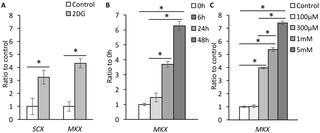Our official English website, www.x-mol.net, welcomes your feedback! (Note: you will need to create a separate account there.)
Control of glucose metabolism is important in tenogenic differentiation of progenitors derived from human injured tendons.
PLOS ONE ( IF 3.7 ) Pub Date : 2019-03-18 , DOI: 10.1371/journal.pone.0213912 Soutarou Izumi 1, 2 , Satoru Otsuru 1 , Nobuo Adachi 2 , Ngozi Akabudike 1 , Motomi Enomoto-Iwamoto 1
PLOS ONE ( IF 3.7 ) Pub Date : 2019-03-18 , DOI: 10.1371/journal.pone.0213912 Soutarou Izumi 1, 2 , Satoru Otsuru 1 , Nobuo Adachi 2 , Ngozi Akabudike 1 , Motomi Enomoto-Iwamoto 1
Affiliation

|
Glucose metabolism is altered in injured and healing tendons. However, the mechanism by which the glucose metabolism is involved in the pathogenesis of tendon healing process remains unclear. Injured tendons do not completely heal, and often induce fibrous scar and chondroid lesion. Because previous studies have shown that tendon progenitors play roles in tendon repair, we asked whether connective tissue progenitors appearing in injured tendons alter glucose metabolism during tendon healing process. We isolated connective tissue progenitors from the human injured tendons, obtained at the time of primary surgical repair of rupture or laceration. We first characterized the change in glucose metabolism by metabolomics analysis using [1,2-13C]-glucose using the cells isolated from the lacerated flexor tendon. The flux of glucose to the glycolysis pathway was increased in the connective tissue progenitors when they proceeded toward tenogenic and chondrogenic differentiation. The influx of glucose to the tricarboxylic acid (TCA) cycle and biosynthesis of amino acids from the intermediates of the TCA cycle were strongly stimulated toward chondrogenic differentiation. When we treated the cultures with 2-deoxy-D-glucose (2DG), an inhibitor of glycolysis, 2DG inhibited chondrogenesis as characterized by accumulation of mucopolysaccharides and expression of AGGRECAN. Interestingly, 2DG strongly stimulated expression of tenogenic transcription factor genes, SCLERAXIS and MOHAWK under both chondrogenic and tenogenic differentiation conditions. The findings suggest that control of glucose metabolism is beneficial for tenogenic differentiation of connective tissue progenitors.
中文翻译:

葡萄糖代谢的控制在源自人类受伤肌腱的祖细胞的肌腱分化中很重要。
葡萄糖代谢在受伤和愈合的肌腱中发生改变。然而,葡萄糖代谢参与肌腱愈合过程发病机制的机制仍不清楚。受伤的肌腱未完全愈合,常诱发纤维性瘢痕和软骨样病变。因为先前的研究表明肌腱祖细胞在肌腱修复中发挥作用,我们询问出现在受伤肌腱中的结缔组织祖细胞是否会改变肌腱愈合过程中的葡萄糖代谢。我们从人类受伤的肌腱中分离出结缔组织祖细胞,这些肌腱是在对破裂或裂伤进行初次手术修复时获得的。我们首先使用从撕裂的屈肌腱中分离出的细胞,通过使用 [1,2-13C]-葡萄糖的代谢组学分析来表征葡萄糖代谢的变化。当结缔组织祖细胞向腱和软骨分化进行时,葡萄糖流向糖酵解途径的流量增加。葡萄糖流入三羧酸 (TCA) 循环和来自 TCA 循环中间体的氨基酸的生物合成被强烈刺激向软骨分化。当我们用糖酵解抑制剂 2-脱氧-D-葡萄糖 (2DG) 处理培养物时,2DG 抑制软骨形成,其特征在于粘多糖的积累和 AGGRECAN 的表达。有趣的是,2DG 在软骨和腱分化条件下强烈刺激腱转录因子基因 SCLERAXIS 和 MOHAWK 的表达。
更新日期:2019-03-19
中文翻译:

葡萄糖代谢的控制在源自人类受伤肌腱的祖细胞的肌腱分化中很重要。
葡萄糖代谢在受伤和愈合的肌腱中发生改变。然而,葡萄糖代谢参与肌腱愈合过程发病机制的机制仍不清楚。受伤的肌腱未完全愈合,常诱发纤维性瘢痕和软骨样病变。因为先前的研究表明肌腱祖细胞在肌腱修复中发挥作用,我们询问出现在受伤肌腱中的结缔组织祖细胞是否会改变肌腱愈合过程中的葡萄糖代谢。我们从人类受伤的肌腱中分离出结缔组织祖细胞,这些肌腱是在对破裂或裂伤进行初次手术修复时获得的。我们首先使用从撕裂的屈肌腱中分离出的细胞,通过使用 [1,2-13C]-葡萄糖的代谢组学分析来表征葡萄糖代谢的变化。当结缔组织祖细胞向腱和软骨分化进行时,葡萄糖流向糖酵解途径的流量增加。葡萄糖流入三羧酸 (TCA) 循环和来自 TCA 循环中间体的氨基酸的生物合成被强烈刺激向软骨分化。当我们用糖酵解抑制剂 2-脱氧-D-葡萄糖 (2DG) 处理培养物时,2DG 抑制软骨形成,其特征在于粘多糖的积累和 AGGRECAN 的表达。有趣的是,2DG 在软骨和腱分化条件下强烈刺激腱转录因子基因 SCLERAXIS 和 MOHAWK 的表达。



























 京公网安备 11010802027423号
京公网安备 11010802027423号